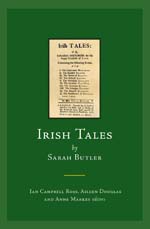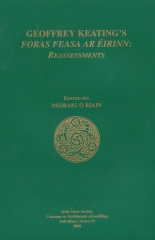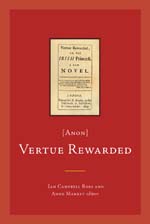Interview with Ian Campbell Ross

Ian Campbell Ross taught at the University of Birmingham from 1975 to 1977. Professor Ross was a co-founder of the Eighteenth-Century Ireland Society/Cumann Eireann san Ochtú Céad Déag and co-founder of the journal Eighteenth-Century Ireland/Iris an dá chultúr which he co-edited from 1986-1995. He was made a Cavaliere nell'Ordine della Stella della Solidarietà Italiana by the President of Italy in 2007. He was a co-founder of the Centre for Irish-Scottish and Comparative Studies and a co-director of the Centre until 2008.
Professor Ross is also the founder and current convenor of the Eighteenth-Century Literature Research Network in Ireland, a network dedicated to linking those with a research or teaching interest in eighteenth-century literature in English in third-level institutions throughout Ireland. The network has members in all Irish universities and holds regular symposia. He is editor for Irish Literature in English for the online literary resource, The Literary Encyclopaedia.
He is principal investigator for the Early Irish Fiction project, a series of annotated, scholarly editions of Irish fiction from 1680 to 1820. Vertue Rewarded and Irish Tales were recently published for this project by Four Courts Press. His co-investigators are Dr. Aileen Douglas, School of English, Trinity College Dublin, and Dr. Moyra Haslett, School of English, Queen's University Belfast. He teaches in the School of English in Trinity College, Dublin.
Shane Creevy reviews Irish Tales and Vertue Rewarded here.
{saudioplayer}IanCampbellRossPolitico.mp3{/saudioplayer}
(Audio: Shane Creevy interviews Professor Ian Campbell Ross)
Professor Ian Campbell Ross, you are the principal investigator for the Early Irish Fiction project. Can you tell me the aims and objectives of this project?
The aims of the project are above all to make available texts from the period 1680 to around 1820, fictional texts, novels, that to a large extent and particularly in the earlier period between 1680 and around 1800 have been largely written out of Irish literary history and the editors who are, besides myself, Moyra Haslett from Queens University Belfast and my colleague here in the School of English Aileen Douglas, are very keen to have this very varied body of fiction represented and available for people to read.
How much of Irish Tales and Vertue Rewarded, recently published by Four Courts Press, romantic titillation and how much is serious literature? Is there a clear demarcation between the two forms?
I think anybody answering the question in 1690 or in 1716, decades when the novels were published, would actually have a hard job to answer the question at all because novels in the late seventeenth and early eighteenth centuries were never thought of as being serious literature and as the novel becomes an increasingly popular form in the course of the eighteenth century, on it’s way becoming the dominant form of imaginative writing, at the moment there are huge debates of cultural politics, about whether or not the novel can be regarded as serious literature or not.
The question of whether it’s a moral form of writing, of who it’s appropriate audience is/are, and also the kind of political uses that it can be put to but from a twenty first century perspective I think these are both extremely serious works of popularisation in political terms.
These are early Irish stories in prose. We’re used to so much stories being told orally. Could the majority of Irish people read these stories first of all and, if so, does this undermine the notion that Ireland has this predominantly oral culture that you find in Yeats and Synge?
I think the Early Irish Fiction series as it develops will certainly pick up as one of its themes the input from Irish oral narrative. But I think in these particular cases what is much more interesting is something different, which is two comparatively or very early examples of Irish print culture.
 Now the two books are different one from the other, but if I could talk for a moment about Irish Tales, one of the real points of interest there is not the importance of oral narrative but the importance of manuscript culture in what is often regarded as being the most characteristic of all print culture forms, the novel.
Now the two books are different one from the other, but if I could talk for a moment about Irish Tales, one of the real points of interest there is not the importance of oral narrative but the importance of manuscript culture in what is often regarded as being the most characteristic of all print culture forms, the novel.
Because Irish Tales very demonstrably draws on Geoffrey Keating’s Foras Feasa extensively and the key point to be made for anyone coming to this novel for the first time published in London in 1716 is that although Keating’s work was known to an elite readership, it was only known in manuscript. It hadn’t been printed at that time. It would only be printed seven years later in translation, published under the title The General History of Ireland by Dermot O’Connor, possibly with the aid of John Tolland.
So that’s seven years after the novel is published. So what you have in Irish Tales is a work which exists very much at the intersection of developing genre of print culture and a essentially dying form of manuscript culture because it is often said that Keating’s Foras Feasa is perhaps the last major historical work in Europe to have circulated primarily in manuscript form.
You say that Sarah Butler used An Foras Feasa extensively but could you tell us what Geoffrey Keating was trying to do with his project An Foras Feasa and how it became such a valuable resource?
Yes, he was offering an account of Irish history from its origins. An Foras Feasa is very much concerned with Irish origins and Keating himself came from an Old English background and I suppose one of the principal things that he was trying to do was to suggest a shared sense of Irish identity between the descendents, the Milesians, the Gaelic Irish, and people like himself, the Old English and suggesting that they have a shared kinship and doing that at a time in the middle of the seventeenth century that follows on from the Elizabethan settlement and so on, where you have not only Old English but also increasingly the New English.
 He’s offering a version of Irish history which sees that history in terms of a series of invasions, a series of settlements, but one which essentially in his version comes to an end or at least a positive conclusion, with the Anglo-Norman invasions of the eleventh century.
He’s offering a version of Irish history which sees that history in terms of a series of invasions, a series of settlements, but one which essentially in his version comes to an end or at least a positive conclusion, with the Anglo-Norman invasions of the eleventh century.
You write that Irish Tales is a “Jacobite reading of early Irish history”. Could you explain what a Jacobite interpretation of history is?
Yes, it’s a very unusual book in that sense, particularly for a book published in 1716, in other words at a period more or less exactly contemporary with the first Jacobite rebellion in 1715, 1716. It was published by a bookseller by the name of Edmund Curll who was known for publishing Jacobite fiction. The name of the author, Sarah Butler, which may not be the author’s real name, is almost certainly a coded way of indicating Jacobite sensibilities, of making readers or prospective purchasers think of James Butler, the Duke of Ormond, who had been secretary to the Old Pretender.
But in terms of its politics, it offers an account of Irish resistance to foreign invasion. Now this is done in terms of Irish medieval history, drawing on episodes from the ninth and the eleventh century as recounted by Keating and the author Sarah Butler produces a coherent narrative that will lead up to the defeat of the invading Danes at the Battle of Clontarf by Brian Boru and the end of foreign domination in Ireland and that particular narrative is obviously susceptible of a Jacobite interpretation, which is in fact how it would have been received – a Jacobite and a Roman-Catholic interpretation. Incidentally there are many features of the book that would be I think that would be understood quite specifically as a defence of Ireland as a Roman-Catholic country
In your introduction to Vertue Rewarded you mention folklore and fakelore. What is the difference between the two and how influential was such lore on Irish prose writing of the long eighteenth century?
This is a very interesting question because... you talk about my introduction it is of course a joint introduction between myself and Dr. Anne Markey my colleague. She is the person who is much more knowledgeable than I am about folklore. When we first began talking about this book without any idea of publishing an edition of it, we’re going back three or four years, we were very interested in one of the interpolated stories in the novel, the story of Cluaneesha.
I should say that the whole of the novel is actually set in the town of Clonmel but of two historical periods: in 1690, which was three years before the book was published, where the main narrative is set, but there’s an interpolated narrative about another earlier Irish princess, the daughter of a King of Munster, a Gaelic princess in other words by the name of Cluaneesha.
 And the tale, which involves a well with magical powers, holy powers, seems very much like folktale and Anne Markey in particular looked very carefully for sources. We contacted a range of folklorists within Ireland and outside Ireland and we’re now pretty much convinced that this isn’t in fact genuine folklore at all but what is called fakelore – something that has the appearance and indeed is designed to have the appearance of genuine folk material but is in fact a pastiche, a parody of that material.
And the tale, which involves a well with magical powers, holy powers, seems very much like folktale and Anne Markey in particular looked very carefully for sources. We contacted a range of folklorists within Ireland and outside Ireland and we’re now pretty much convinced that this isn’t in fact genuine folklore at all but what is called fakelore – something that has the appearance and indeed is designed to have the appearance of genuine folk material but is in fact a pastiche, a parody of that material.
Now of course that raises the very interesting question of why it’s there in the first place and the simple answer to that is that Vertue Rewarded is a novel which sets different understandings of what constitutes civilisation against barbarism in the context of a long history of English writing that understood medieval – even in the seventeenth century – Ireland as a barbarous society and the author of Vertue Rewarded is very keen to defend Ireland against those kinds of charges, not only to defend modern Ireland, seventeenth century Ireland, but also to defend medieval Ireland against that.
And so the interpolated story has this very clear, I hesitate to call it a subtext because I think it is perhaps more on the surface than that, it has the purpose within the story of indicating that the Irish princess of medieval times was like the modern heroine of the book: an exemplar of virtue.
Ireland in the past is often characterised as somewhat insular. But the tale of Faniaca (in Irish Tales) undermines this I think. How influential were foreign stories on Irish writing at the time or is this just a lone case?
No I think the whole history of fiction in English, and of course we have to recognise, going back to an earlier question, that novels at the time were themselves a form of elite writing. They were clearly designed for a much wider public than some other forms of writing – history writing for instance, ambitious poetry, the kinds of books that might have appeared in large very expensive folio volumes. Novels characteristically were much smaller, much cheaper, economical versions.
But seventeenth century fiction, more generally, in English, often drew on exotic locations. Now some of the more familiar of those might be, to move forward slightly, something like Robinson Crusoe for instance which has very exotic geographical material, or slightly before Vertue Rewarded was published, something like Aphra Behn’s Oroonoko, I think its within that context that you have to understand the exotic materials within Irish Tales.
And of course what you’re talking about there is the story of a South American woman from Antisuyu, from this region outside of the Inca Empire, who relates a story of how she came to end up in Clonmel. It is very exotic.
If you look at other examples of early Irish fiction in the seventeenth century, you could look at, for instance, Roger Boyle’s Parthenissa which is an example of French romance, but you could also look at Nahum Tate’s continuation of the Ethiopian history which is a classical story, you could look at Robert Boyle’s version of Christian history.
So I think that writers of early fiction at the end of the seventeenth and beginning of the eighteenth century were actually very often interested in what one might call generally exotic locations, whether these are recessed in time or set in faraway places.
But the very particular use of South America in Vertue Rewarded is especially interesting because it gave a specific source and that specific source is the translation of the Inca Garcilaso de la Vega’s Royal Commentaries, a translation which had been made by a very distinguished diplomat Paul Rycaut, and which had been made in part, in large part in fact in Ireland in the 1680s when Paul Rycaut was chief secretary in Ireland.
You wrote a biography of Laurence Sterne.
That’s right.
What do you think of the idea that Laurence Sterne’s Tristram Shandy and Swift’s Gulliver’s Travels were the beginning of the kind of experimental post-modern fiction that is being produced so widely today?
I think the role of Tristram Shandy as a forerunner of post-modern experimental fiction is absolutely the case. It is a work that I teach very often so I have the chance to encounter people who are reading it for the very first time and they’re simply amazed for the most part that this is a book that was actually published in 1759, 1760s.
Having said that, it’s also a novel which depends on the existence of a shared idea of what novels could be or what novels should be that develops during the course of the eighteenth century. The Russian formalist critic Viktor Scklovsky, writing in the 1920s, described it as the most typical novel of world literature and one can understand what he means because what Sterne does in many ways is to take characteristic narrative tropes, certain kinds of subject matter, both to first of all disassemble them and then reassemble them in a rather different way.
But the influence of Tristram Shandy on development of all, many kinds of experimental fiction is absolutely clear and I suppose the very best example of that is the tribute that Joyce paid to Sterne when he was writing A Work In Progress. He was trying to explain what A Work In Progress (which of course would become Finnegan’s Wake) was about and when he did that he described some of the things that are in it. He says it is characteristic of all novels: man, woman, life, death, birth, sleep, and so on, and he says well I’m frankly trying to put many planes into a single narrative and he asks a rhetorical question of his correspondent, have you ever read Laurence Sterne?
Professor Ian Campbell Ross thank you very much for taking the time to talk to us.
Thanks very much.
{jathumbnailoff}
